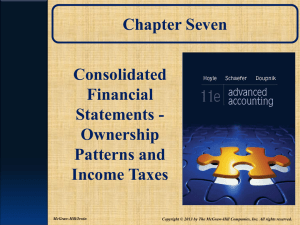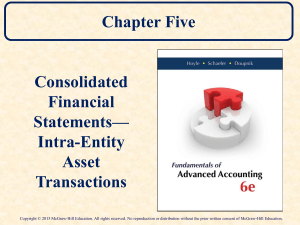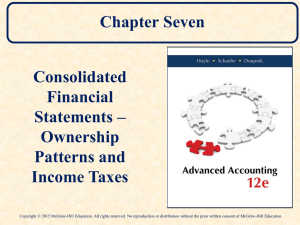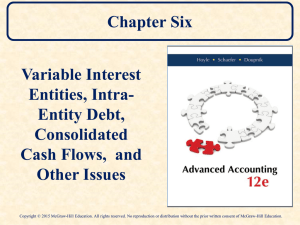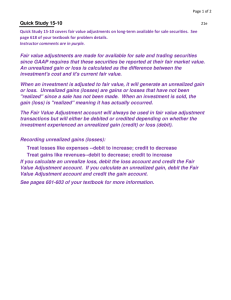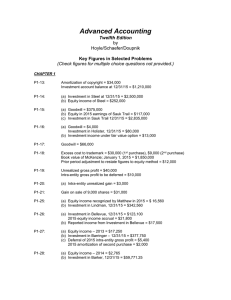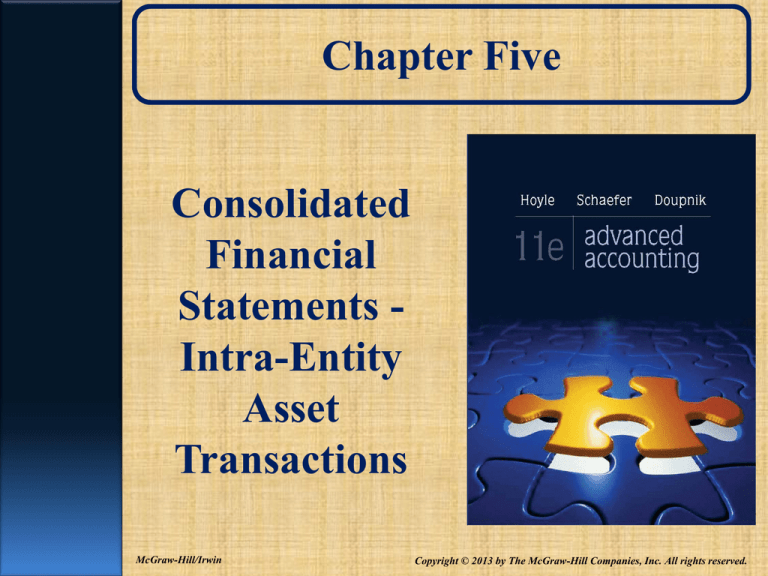
Chapter Five
Consolidated
Financial
Statements Intra-Entity
Asset
Transactions
McGraw-Hill/Irwin
Copyright © 2013 by The McGraw-Hill Companies, Inc. All rights reserved.
LO 1
Intra-entity Transactions
When companies affiliated through common control
engage in intra-entity inventory transfers,
consolidation procedures are required to eliminate
sales and purchases balances.
Transactions between a parent and subsidiary are
considered “internal” transactions of a single entity.
Effects of intra-entity transactions should be
eliminated from the consolidated financial statements.
Consolidated statements must reflect only transactions
with outside parties.
5-2
Sales and PurchasesIntra-entity
LO 2
ENTRY TI (Transferred Inventory)
Eliminate all intra-entity sales/purchases of inventory
by eliminating the sales price of the transfer – which
one company records as sales, and the other records
as cost of goods sold.
CONSOLIDATION RECORD
Date
Description
Page
Debit
Sales
Cost of Goods Sold
##
Credit
$$$
$$$
ENTRY TI (Eliminates "transferred inventory")
The total recorded amounts are deleted.
5-3
Unrealized Gross Profit –
Intra-entity
LO 3
ENTRY G (Gross Profit)
•
Despite Entry TI, ending inventory may still be overstated due to the
transfer price exceeding historical cost. Intra-entity profits that remain
unrealized at year-end must be removed in arriving at consolidated figures.
Unrealized gain is eliminated as follows in Year 1:
CONSOLIDATION RECORD
Date
Description
Page
Debit
##
Credit
Cost of Goods Sold
$$$
Inventory
$$$
ENTRY G
To remove unrealized gross profit created by intra-entity sale
Note: The consolidated company has earned the profit on any
portion of the intra-entity transaction that was sold to
unrelated parties and does not need to make an adjustment for
the sold items for consolidation purposes.
5-4
LO 4
Unrealized Gross Profit –
Intra-entity
ENTRY *G
From a consolidated view, the buyer’s Cost of Goods Sold (the
beginning inventory component) and the seller’s Retained
Earnings accounts as of the beginning of Year 2 contain the
unrealized profit, and must both be reduced in Entry *G in
Year 2.
CONSOLIDATION RECORD
Date
Description
R/E (Beg. Bal. of seller)
COGS (Beg. Inv. Component)
ENTRY *G
Page
Debit
$$$
##
Credit
$$$
Entry *G removes unrealized gross profit from beginning
figures so that it is recognized in the consolidated income in
the period in which it is earned.
5-5
Unrealized Inventory Gain –
Downstream Transfers
Worksheet entries to eliminate sales/purchases
balances (Entry TI) and to remove unrealized gross
profit from ending Inventory in Year 1 (Entry G) are
standard, regardless of the circumstances of the
consolidation.
BUT the procedure to eliminate intra-entity gross
profit from Year 2’s beginning account balances
differs from the Entry *G just presented IF:
(1) the original transfer is downstream (parent’s) and
(2) the parent applies the equity method for internal
accounting purposes.
5-6
Intra-entity Transactions –
Downstream Transfers
ENTRY *G
If the transfer of inventory is downstream AND the
parent uses the equity method, the following entry is
used to recognize the remaining unrealized profit left at
the end of the previous year.
CONSOLIDATION RECORD
Date
Description
Investment in Subsidiary
COGS (Beg. Inv. Component)
ENTRY *G
Page
Debit
$$$
##
Credit
$$$
Investment in Subsidiary account replaces the Retained
Earnings account used for upstream sales.
5-7
LO 5
Unrealized Gross Profits –
Effect on Noncontrolling Interest
Accounts affected by intra-entity transactions:
Revenues
Cost of Goods Sold
Expenses
Noncontrolling Interest in Subsidiary’s Net Income
Retained Earnings at the Beginning of the Year
Inventory
Land, Buildings, and Equipment
Noncontrolling Interest in Subsidiary at End of Year.
5-8
Intra-Entity Inventory Transfers
Example
Three entries require attention in the calculation of
noncontrolling interest in the sub’s net income December 31, 2013.
Entry *G removes unrealized gross profits (25% rate) carried
over from the previous period intra-entity downstream sales.
Entry *G reduces Cost of Goods Sold (or beginning inventory
component) which creates an increase in current year income.
Gross profit is correctly recognized in 2013 when inventory is sold
to an outside party.
The debit to the Investment in Bottom account brings that account
to a zero balance in consolidation.
5-9
Intra-Entity Inventory
Downstream Transfer - Example
Entry TI eliminates the intra-entity sales/purchases for 2013.
Entry G defers the unrealized gross profit (30% rate) of
$6,000remaining at the end of 2013.
Entry G eliminates the overstatement of Inventory as well as
the ending component of Cost of Goods Sold which decreases
consolidated income.
5-10
Intra-entity Transactions –
Upstream Inventory Transfer
Entry S eliminates a portion of the parent’s investment
account and provides the initial noncontrolling interest
balance.
The entry also removes stockholders’ equity accounts of
the subsidiary as of the beginning of the current year.
5-11
Intra-entity Transactions –
Land Transfer
LO 6
ENTRY TL
If land is transferred between the parent and sub at a gain,
the gain is considered unrealized and must be eliminated.
CONSOLIDATION RECORD
Date
Description
Gain on Sale of Land
Land
ENTRY TL
Page
Debit
##
Credit
$$$
$$$
Note: By crediting land for the same amount, this
effectively returns the land to its carrying
value on the date of transfer.
5-12
Intra-entity Transactions -Land Transfer
ENTRY *GL
As long as the land remains on the books of the
buyer, the unrealized gain must be eliminated at the
end of each fiscal period.
CONSOLIDATION RECORD
Date
Description
R/E (Beg. Bal. of seller)
Land
ENTRY *GL
Page
Debit
##
Credit
$$$
$$$
Note: The original gain was closed to R/E at the end of
that period. When we eliminate the gain in
subsequent years, it must come from R/E.
5-13
Intra-entity Land Transfers
Eliminating Unrealized Gains
ENTRY *GL (Year of sale)
In the period the land is sold to a third party, the
unrealized gain must be eliminated one more time,
and also finally recognized as a REALIZED gain in
the current period’s consolidated financial
statements.
CONSOLIDATION RECORD
Date
Description
R/E (Beg. Bal. of seller)
Gain on Sale of Land
ENTRY *GL (Year of sale)
Page
Debit
##
Credit
$$$
$$$
Note: Modify the entry to credit the Gain account
instead of Land.
5-14
LO 7
Intra-entity Transactions -Depreciable Asset Transfers
ENTRY TA
In the year of transfer, the unrealized gain must be
eliminated and the assets restated to original
historical cost.
5-15
Intra-entity Transactions -Depreciable Asset Transfers
ENTRY ED
In addition, the buyer’s depreciation is based on the
inflated transfer price. The excess depreciation
expense must be eliminated.
5-16

